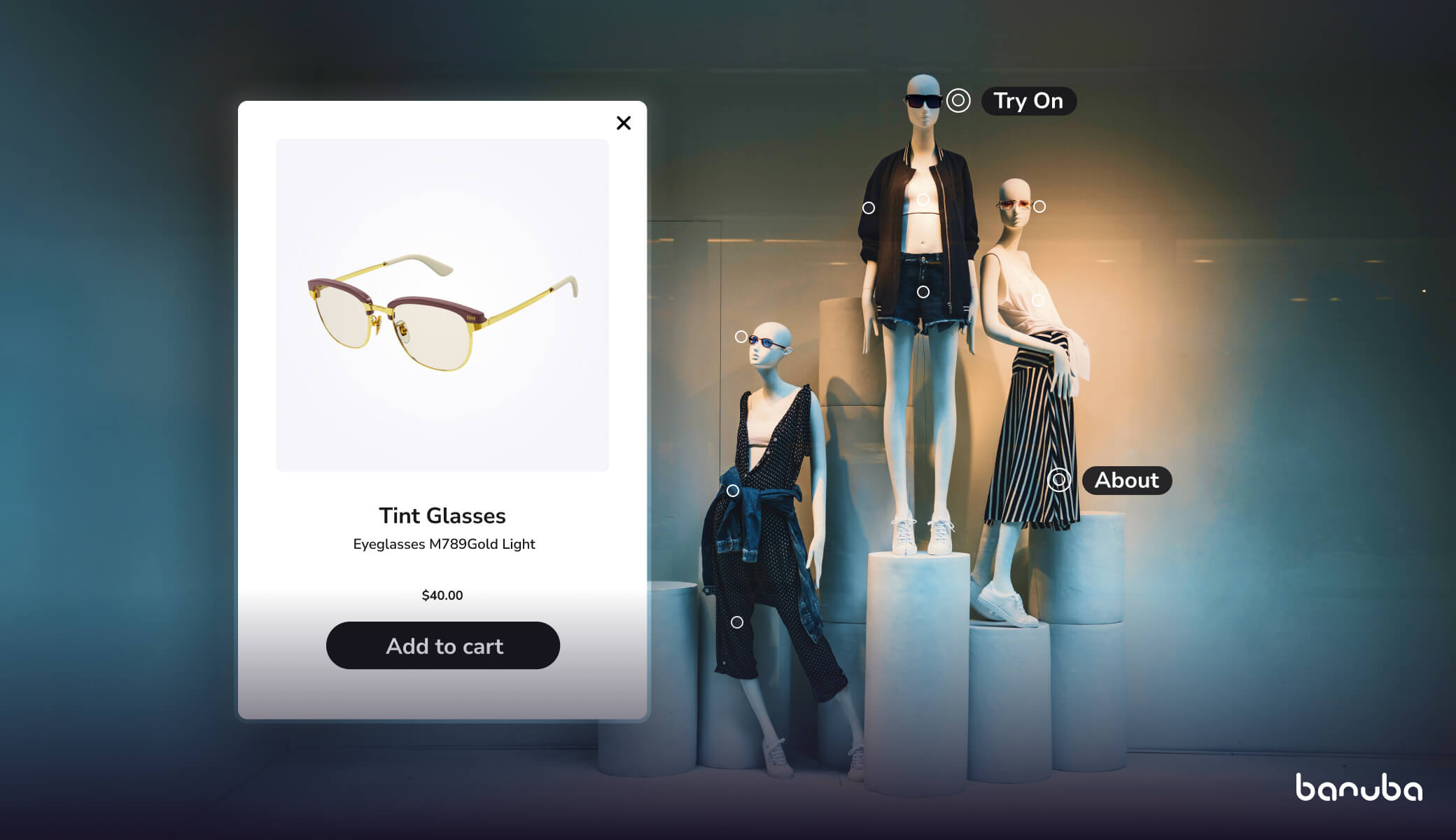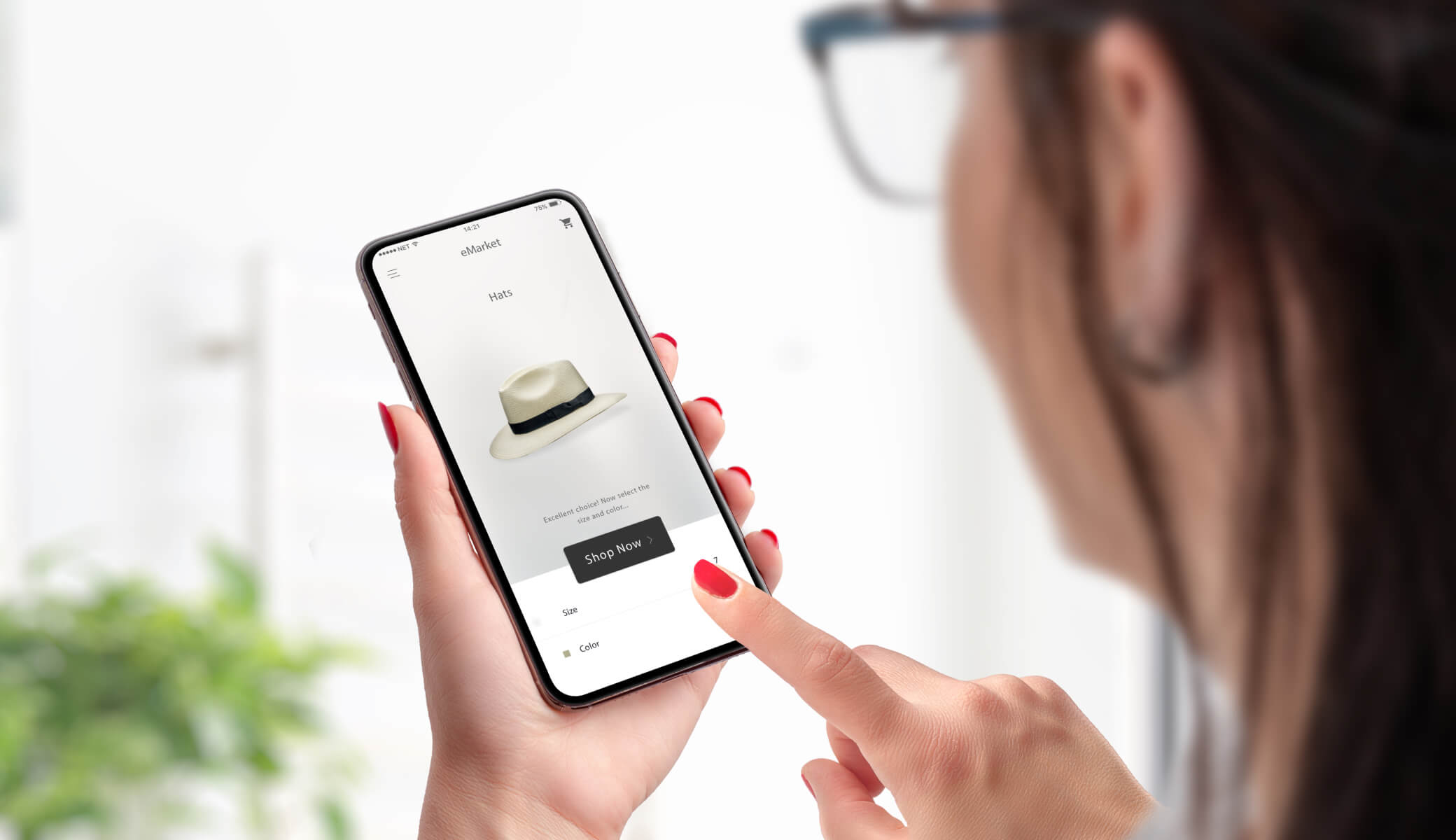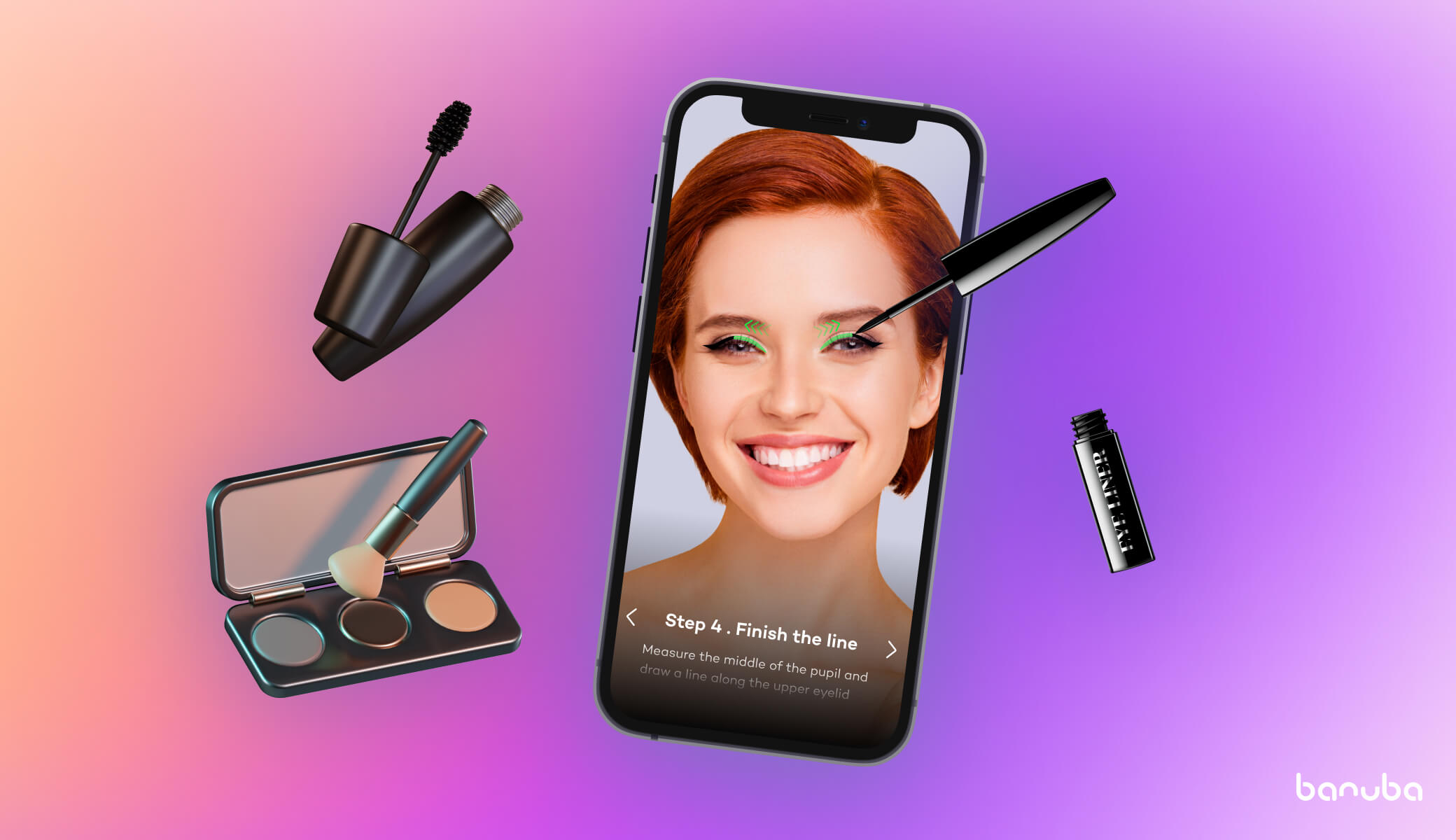What Is A Virtual Store? How Does It Work?
Advanced technologies gradually transform real-life experiences into a twist from sci-fi. With almost 3k brick-and-mortar shops being closed in 2023 and the prediction of closing 25% of all US malls by 2025, e-commerce shifts the traditional paradigm.
While the digital try-on has become a new norm, with 61% of consumers preferring brands with AR-based shopping experience, a virtual store still seems like a new concept for online shopping. This notion transcends the conventional boundaries of brick-and-mortar stores and e-commerce. Let's dig deeper into this concept and see how retailers and brands can implement it for their benefit.


What Is A Virtual Store?
A virtual store is an intricate digital reproduction of a physical retail store, carefully designed to allow consumers to interact with products in a digital environment. These virtual shopping experiences are brought to life through a fusion of cutting-edge technologies, including augmented reality (AR) and virtual reality (VR).
Within a virtual store, customers utilize personal devices like smartphones, laptops, tablets, or VR headsets to navigate a digital representation of a physical store.
Virtual shops aim to provide an immersive shopping environment, enabling virtual store visitors to browse, select, and even make purchases.
They can emulate the look and feel of real-world retail spaces or transport shoppers to entirely new and imaginative settings, making them a versatile tool for various sectors within the retail industry.
The Magic Behind The Virtual Shopping — How Does A Virtual Store Work?
The enchantment of virtual shopping lies in integrating cutting-edge technologies that work in concert to create an alluring and engaging shopping adventure. These technologies include:
Augmented Reality (AR): AR overlays digital elements onto the real world, enriching the user's perception of their surroundings. In virtual shops, AR is harnessed to project digital product displays and information onto the user's devices, creating a seamless blend of the digital and physical worlds.
Artificial Intelligence (AI): AI plays a pivotal role in personalizing the virtual shopping experience. AI algorithms analyze user behavior and preferences to offer product recommendations and provide tailored assistance, mimicking the expertise of an in-store sales associate.
3D Modeling: Creating accurate and detailed 3D models of products is essential for an authentic virtual store. These models enable online customers to view and interact with products from all angles, facilitating a detailed examination of textures and features.
User Interface (UI) Design: User-friendly interfaces ensure that customers can easily navigate virtual stores, search for products, and complete purchases. Intuitive UI design is paramount for smooth and enjoyable shopping.
E-commerce Integration: Virtual shops are typically integrated with e-commerce platforms, allowing customers to make purchases directly from the virtual environment. Inventory and pricing information are synchronized in real time to ensure accuracy and reliability.
Virtual Stores vs. Online Stores
Virtual stores are often compared to traditional online shops, but they offer fundamentally different shopping experiences. While online stores are web-based platforms where customers view product listings and make purchases, a virtual retail space seeks to recreate the in-person shopping experience, fostering a deeper level of customer engagement. Here are the key distinctions:
Immersion: Virtual shopping provides an immersive in-store shopping experience, allowing customers to 'walk' through a digital space, interact with products, and make choices in a manner that online shops cannot replicate.
Visualization: It offers a more lifelike visualization of products, making them ideal for items where appearance and spatial relationships are pivotal, such as furniture and clothing.
Personalization: Virtual shopping often relies on AI to provide personalized product recommendations and assistance, echoing the personalized service online shoppers might receive in a physical store.
Interactivity: Virtual shopping empowers customers to engage with products beyond the confines of static images. For example, they can try on clothes online, evaluate furniture placement, or visualize how cosmetics would appear on their skin.
Engagement: Virtual stores aim to heighten customer engagement and dwell time, creating a sense of connection to the brand and products. This contrasts with the often transactional nature of online shopping.
However, any online store can offer a virtual shopping experience. You just need to find a reliable tech partner to integrate a solution into your business.
Types of Virtual Stores
Virtual shopping comes in various forms, each tailored to specific retail objectives and customer experiences. Here are four primary types of virtual stores:
Fully Virtual Stores
Fully virtual stores replicate physical retail spaces in a digital environment. Customers can explore a 3D representation of the store, interact with products, and make purchases. This type is popular in sectors like fashion and beauty, where customers seek an experience closely aligned with in-store shopping.
Brands like Ralph Lauren, Bloomingdale's, and J.Crew offer virtual shopping to their online customers, turning their retail stores into snow-covered chalets, high-fashion fitting rooms, and cozy salons. The brands integrated the in-store experience online to celebrate their anniversaries.
Virtual Try On
Virtual try-on stores focus on enabling customers to try on products digitally. This is commonly used in the fashion and beauty industries, allowing online shoppers to see how clothing, makeup, or accessories look on them through the use of AR technology.
Virtual Clienteling
Virtual clienteling stores center around building personal relationships with customers in the digital space. They often provide personal shoppers or assistants who guide customers through their shopping journey, offering recommendations and advice.
Luxury fashion brand Burberry introduced a virtual clienteling initiative that enables customers to connect with in-store associates through video calls. These associates provide personalized assistance and product recommendations, replicating the one-on-one support traditionally offered in physical stores.
Virtual Placement
Digital placement stores are particularly beneficial for furniture and home decor retailers. They enable customers to visualize how furniture and decor items would fit in their own spaces, helping them make informed purchase decisions.
Virtual Shopping — Personalized Physical Stores in Customers' Pockets
Virtual shopping platforms offer a multitude of benefits for both retailers and online customers, revolutionizing the way we shop. Let's delve into these advantages in detail, supported by comprehensive data and statistics:
Benefits of Virtual Stores for Retailers
Boost Customer Satisfaction
Virtual shopping enhances the overall experience, providing customers with interactive and engaging ways to explore products. Higher customer satisfaction often leads to increased loyalty and repeat business.
As people are involved in AR, their cognitive activity and engagement doubles. This leads to a better consumer response and a more memorable online shopping experience, increasing the likelihood of returning.
In addition, the digital fitting feature inside the virtual shopping space can cut the return rates, which can reach 40% for online sales. And returning products definitely doesn't help customer satisfaction.
Human Touch
Virtual stores can incorporate AI-driven personal shopper assistants or online clienting, adding a human touch to the digital shopping experience. This personalization fosters a stronger emotional connection between customers and brands.
Despite revolutionary approaches to communication, interaction remains an important part of the shopping experience. Brands can combine online sales associates with AI-driven virtual shopping using virtual assistants.
Reduce Customer Retention
By providing customers with a seamless and immersive shopping experience, virtual stores can help reduce customer retention rates. According to research, only three out of ten customers in online stores will be loyal to a brand within a year.
Virtual stores, however, offer the in-store experience with the opportunity to try and "touch" what you buy. According to NielsenIQ, a bit more than 50% of consumers prefer AR to evaluate and review the items they plan to purchase. Clients are less likely to abandon their shopping journey due to frustration or inconvenience, as their customer expectations are more than fulfilled.
Increase Foot Traffic
Virtual shopping works like magic regardless of store locations, transporting people right to the digital storefront.
A virtual reality store can be accessed from anywhere at any time, eliminating brick-and-mortar stores' physical limitations. This accessibility increases the potential foot traffic for retailers, allowing them to reach a broader audience and new markets.
People who shop online become brand advocates and advertise your products without you even noticing. You just need to give them an experience they want to scream about.
Flexibility and Availability
Virtual shopping experiences offer flexibility and availability that physical stores cannot match. Customers can shop conveniently, and retailers can quickly update product listings and promotions.
Reduce Cost
Operational costs associated with physical retail, such as rent, utilities, and staffing, are significantly reduced in virtual stores as bytes are definitely cheaper than square feet. This cost efficiency can lead to higher profit margins for retailers.
Let's do simple math. The average cost for renting one square foot in America in 2022 was $27. Renting a 500-square-foot premises would cost $13,500 per month, having a significant impact on the company's budget.
Development of virtual stores in the metaverse, however, can cost from $10,000 to 400,000, depending on the complexity level. And if you "rent" the space in the metaverse and virtual store that is fully tailored to your needs from a reliable tech partner, the price can be even more delightful.
Increase Sales
The immersive and interactive nature of virtual stores can lead to higher online conversions and increased average order values. The ability to try products online and receive personalized recommendations can drive impulse purchases and upselling.
According to a recent research by Obsess, 70% of virtual stores' users purchased at least one item from a brand after a visit. In turn, Shopify states that using 3D models and augmented reality technology in online shopping can boost conversion rates by 94%.
Improve Customer Experience
Virtual shopping provides memorable and enjoyable customer experiences. This positive experience can lead to word-of-mouth recommendations and social media sharing, further expanding a retailer's reach.
According to PwC, the in-store experience influences 20% of buyers at the early stage of interaction. It shapes their customer loyalty and whether they would stick with a brand.
A virtual store builds a bridge between online and offline channels, enabling more touchpoints that can overall enhance the customer journey.
Examples of Virtual Stores
To illustrate the real-world application and success of the online retail landscape, here are a few notable examples:
Banuba Multiproduct Virtual Store Platform
The Multiproduct Virtual Store Platform from Banuba can transform any retail store into a virtual storefront and offer customers unparalleled shopping adventure at the palm of their hands and the comfort of their homes.
Banuba offers a virtual shopping technology powered by AI and AR solutions with patents. The platform is available on most devices with a camera, Internet connection, and a screen. Once inside the virtual world, a user can explore the items displayed on counters, try them on, examine the 3D models, learn the characteristics, compare, and purchase online in just a few clicks.
The AI-powered personalization leverages customer data provided through the camera to offer the best-matching goods, just like during the in-store experience in real life. The algorithms analyze the user's unique features and characteristics to offer product recommendations.
Thus, when it comes to makeup, it considers skin tone and color type; age, skin type, and possible imperfections help find suitable skincare; the facial composition and shape will help determine the appropriate accessories. The smart sales assistant will do the job without biased opinions.
If you want to test how virtual shopping works, check out the demo and immerse yourself in the world of the virtual store experience.
Sephora Virtual Artist
This product from Sephora is an AR application that allows customers to try makeup products online. Users can see how different cosmetics appear on their skin, making it easier to select products that match their preferences. The personalized experience offered by Sephora's virtual store assists customers in making informed choices and drives conversions.
Charlotte Tilbury's Online Beauty Shop
Charlotte Tilbury's Online Beauty Shop is a fully virtual store, setting new standards in the beauty retail world. Accessible on mobile, tablet, or computer, it offers immersive and customizable shopping.
Upon entering, a user can create a personalized avatar.
Users can also try on makeup products using their device's camera. All the items are available for purchase.
The digital experience also includes fun elements, like riding a moped to a dance party room. Consumers join the dance party, change the music, invite friends, and even collect rewards like tokens.
Dior Beauty
The Dior Beauty Virtual Store, a collaboration with Harrods, is a novel and enchanting retail experience that marries the digital and physical worlds seamlessly. This 'Atelier of Dreams' offers timeless and location-free shopping, available 24/7.
Visitors can ascend Dior Beauty's signature tree to reach the Exclusive Dior Garden, a magical winter wonderland featuring limited-edition cosmetics and perfumes. Shoppers can schedule private in-store showings, adding a personal touch. This virtual store complements Harrods' in-store pop-up experience, enhancing interactivity and enabling direct purchases of Dior Beauty products, creating a unique blend of physical and virtual shopping.
If you want to adopt virtual shopping, finding a reliable tech partner will be a good place to start.




